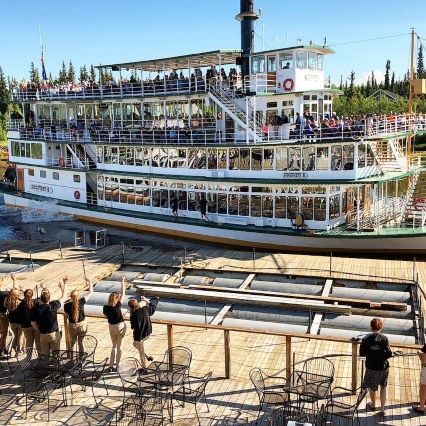A touch of Europe on the prairies
French flavour is evident in every corner of Gravelbourg
French Canadian priest Father Louis-Pierre Gravel founded Gravelbourg in 1906. He was charged with moving his family, his culture and his religion to this hand-picked spot as a way of establishing a presence for both French-speaking Canada and the Catholic church. When more than 10,000 francophone settlers answered his call from all over eastern Canada and the U.S., the area surrounding Gravelbourg became steeped in French tradition.
Today that culture and its religious roots is evident in the magnificent original architecture that graces the streets of Gravelbourg. The town has a European feel that’s been enhanced by the recent beautification efforts of business owners and residents under the guidance of museum curator Louis Stringer. After a trip to France, Stringer encouraged the town to add bricked sidewalks, wrought-iron signage and old-fashioned streetlamps as a way of enhancing the town’s old world feel.
“We wanted to showcase the dualistic nature of our community, but didn’t want to ignore the multi-ethnic diversity of the town,” said Stringer of the Gravelbourg’s promotional theme. “We wanted to encompass a genuine feel for all of Europe and be inclusive of the many cultures that now make up Gravelbourg.”
Architecture and art
At the heart of Gravelbourg is the magnificent co-cathedral. (A co-cathedral is a church which shares the function of being a bishop’s seat with another cathedral, in this case the Holy Rosary Cathedral in Regina.) The church was built of Claybank brick and Tyndall stone, common local building materials that can be seen in buildings all along Gravelbourg’s First Avenue. While the exterior of the Cathedral is undoubtedly stunning, it is the interior that has left unsuspecting visitors breathless.
It took French-born parish priest Father Charles Maillard from 1921 to 1931 to complete the cathedral’s fully painted interior. During that 10-year period Father Maillard was often found high up on scaffolding, lying on his back, painting the church’s high arched ceilings, Sistine Chapel-style.
“All of the paintings you see inside the cathedral were done by Father Maillard,” said Stringer, “but he didn’t sign a single painting, because he considered himself a priest first and an artist second.”
The importance of Gravelbourg in the eyes of the Catholic church can also be seen in the educational institutions that were erected there, including College Mathieu and the Convent of Jesus and Mary, which were established to bring a heightened level of education to the prairies and to help francophones throughout the west achieve a French Catholic education. While the original College Mathieu buildings were destroyed by fire, one can still see the imposing architecture of the convent. Though it is no longer under the guidance of the order which once graced its halls, the convent still retains its original mission as a multipurpose education center for the town.
Art enthusiasts, enticed to the area by the paintings inside the cathedral, should also be sure to visit the library inside the convent to see a collection of reproductions of masters of the renaissance period and a religious statue which was created in Italy.
Stringer and the museum have constructed a guided tour to help visitors learn more about the incredible architecture and art that are such an integral part of Gravelbourg’s history.
“Throughout the summer months,” said Stringer, “the museum offers guided tours of all our historical buildings.”
For those who travel outside the June to August tour window, an interactive heritage walking tour map can also be found on the town’s website.
Stop and stay
Yet another fine example of the rich architecture that symbolizes Gravelbourg is the historic bishop’s residence. Now a bed and breakfast, with a meadow that lies between it and the convent, the building is also available for those campers looking to park their trailers while they take in the sights.
Those looking for a more rustic experience can visit one of the two regional parks that lie in close proximity to Gravelbourg.
At Shamrock Regional Park, located approximately 32 kilometres from Gravelbourg, visitors can take a dip in the pool, angle for one of nine species of fish that inhabit the Wood River, golf at the park’s challenging nine-hole sand green course or take a hike or bike ride along one of the many trails along the river, including a portion of the Saskatchewan Birding Trail.
Closer to Gravelbourg lies Thompson Lake Regional Park, where boaters and fishermen will find a marina and a well-stocked lake of walleye and northern pike. Swimmers can take a jump off the local pier or splash about in the park’s heated pool and golfers will find a nine-hole grass-greens course, with 18 tee boxes that allow for a full 18 holes to be played.
Celebrate the summer
There’s also something for foodies and music lovers when Gravelbourg’s Solstice Festival happens in late June.
An open-air concert that runs all day Saturday is preceeded by a multicultural food festival on the Friday. This is a festival that Stringer said highlights the cultural diversity of the community, both past and present.
“Because we have so many different nationalities in town now,” said Stringer, “we like to feature their food, their culture and their music. After the open-air concert on Saturday that features performers in both French and English there is also an ecumenical service that takes place in the cathedral on the Sunday.”
A charming town that welcomes you with both its culture and its style, Gravelbourg is truly where you’ll find a touch of Europe on the prairies.






